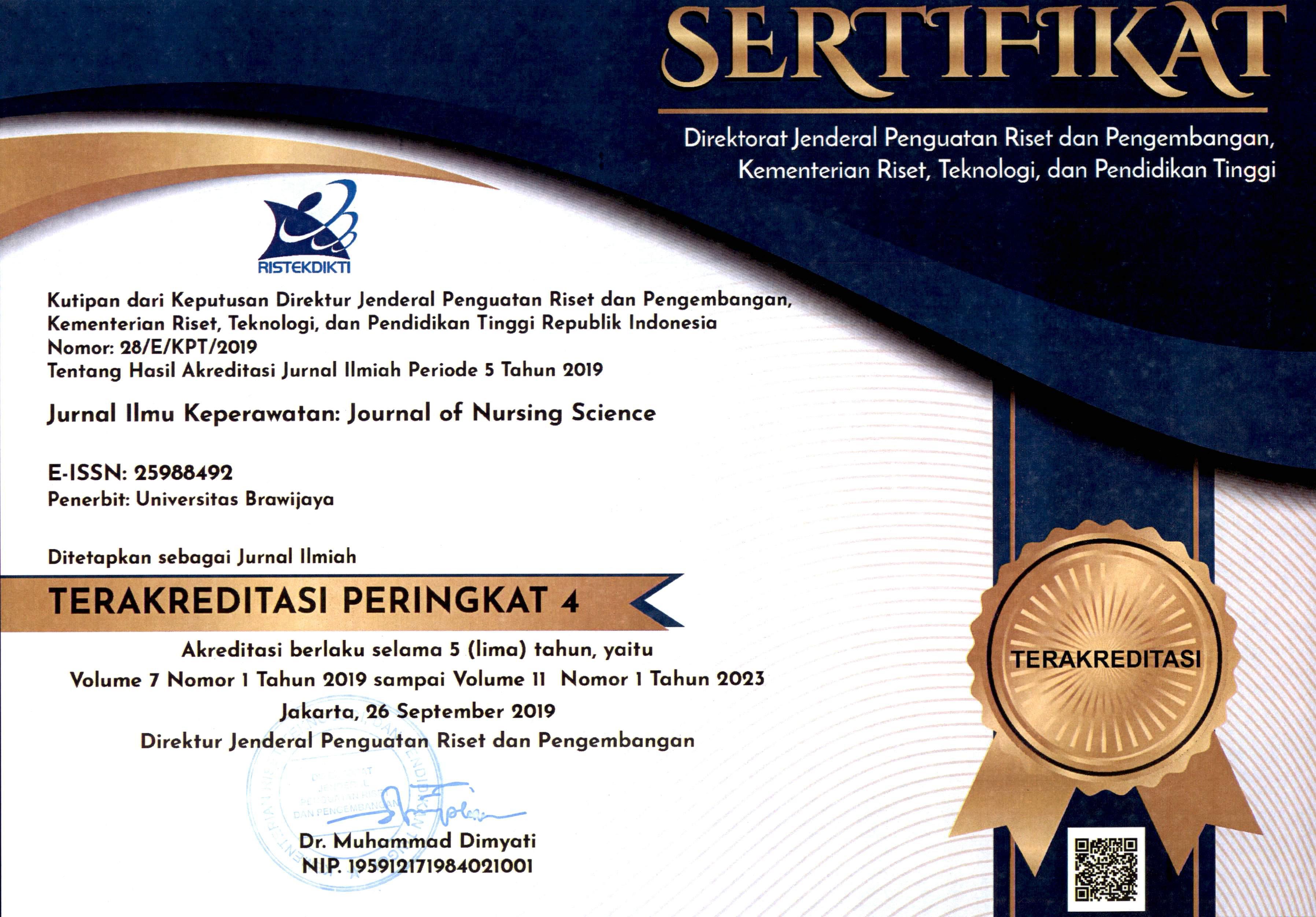Effect of Woolen Cloth to Maintain Temperature 39°C of Crystaloid Fluid Ringer Lactate at Room Temperature 18°C
DOI:
https://doi.org/10.21776/ub.jik.2021.009.01.8Keywords:
Crystalloid liquid, Ringer Lactate 39áµ’C, Woolen cloth, Temperature dropAbstract
References
- American Heart Association. (2018). Part 8: Advanced Challenges in Resuscitation Section 3: Special Challenges in ECC. AHA Journals: Circulation, 102, 229-252.
- Benyamin, L. (2002). Dasar-dasar Klimatologi I. Raja Grafindo Persada: Null.
- Blumberg, N. et al. (2018). 0.9% NaCl (Normal Saline) – Perhaps not so normal after all?. Transfusion and Apheresis Science, Elsevier Ltd, 57, 127–131.
- Hamid, A. (2007). Kalor dan Termodinamika. Diktat Kuliah Termodinamika Program Studi Pendidikan Fisika, Universitas Negeri Yoyakarta.
- Idawati Supu, Baso Usman, Selviani Basri, S. (2016). Pengaruh Suhu Terhadap Perpindahan Panas pada Material yang Berbeda. Jurnal Dinamika, 23(45), 5–24.
- Intang, A., Darmansyah. (2018). Analisa Termodinamika Laju Perpindahan Panas Dan Pengeringan Pada Mesin Pengering Berbahan Bakar Gas Dengan Variabel Temperatur Lingkungan. Jurnal Teknik Mesin Untirta, 4(1), 34 – 38.
- Istinharoh (2013). Pengantar Ilmu Tekstil 1: Sekolah Menegah Kejuruan Semester 1. Jakarta: Kementrian Pendidikan dan Budaya: Direktorat Pembinaan Sekolah Menengah Kejuruan.
- Nayoko (2016). Perbandingan Efektifitas Pemberian Cairan, Jurnal Keperawatan Muhammadiyah, 1(1), 86–92.
- Rohyami, Y. (2014). Kimia Fisika. Deepublish: Yogyakarta.
- Stewart, R. (2018). Advance Trauma Life Support Student Course Manual. 10th edn. United States of America: American College of Surgeons.
- Wang, Y. C. & Lin, Y. K. (2014) Association between temperature and emergency room visits for cardiorespiratory diseases, metabolic syndrome-related diseases, and accidents in metropolitan Taipei. Plos One, 9(6), 1–9.
Downloads
Published
How to Cite
License
Authors published in this journal agree to the following terms:
1. The copyright of the received article shall be assigned to the journal as the publisher of the journal. The intended copyright includes the right to publish the article in various forms (including reprints). The journal maintains the publishing rights to the published articles.
2. Authors may enter into separate additional contractual agreements for the non-exclusive distribution of the published journal version of the work (for example, posting it to an institutional repository or publishing it in a book), with acknowledgment of their initial publication in this journal.
3. Authors are permitted and encouraged to post their work online (e.g. in an Institutional Repository or on their website) before and during the submission process, as this can result in a productive exchange, as well as earlier and larger citations of the published work.
4. Articles and all related material published are distributed under Creative Commons Attribution-NonCommercial 4.0 International License or CC BY-NC 4.0 license.
JNSU is licensed under a Creative Commons Attribution-NonCommercial 4.0 International License or CC BY-NC 4.0 license.
Most read articles by the same author(s)
- Muhammad Rosyidul `Ibad, Tina Handayani Nasution, Sri Andarini, PENGARUH EKSTRAK DAUN KERSEN (Muntingia calabura) TERHADAP DERAJAT ERITEMA PADA PROSES INFLAMASI MARMUT (Cavia porcellus) DENGAN LUKA BAKAR DERAJAT II DANGKAL , Journal of Nursing Science Update (JNSU): Vol. 1 No. 2 (2013)
- Moh. Ubaidillah Faqih, Ahsan Ahsan, Tina Handayani Nasution, ANALISIS FAKTOR YANG MEMPENGARUHI KEMANDIRIAN PADA PASIEN CEDERA KEPALA YANG PERNAH DIRAWAT DI IGD RSUD DR. R. KOESMA TUBAN , Journal of Nursing Science Update (JNSU): Vol. 5 No. 1 (2017)
- Setyoadi Setyoadi, Tina Handayani Nasution, Amanda Kardinasari, FAMILY SUPPORT IN IMPROVING INDEPENDENCE OF STROKE PATIENTS , Journal of Nursing Science Update (JNSU): Vol. 6 No. 1 (2018)
- Tina Handayani Nasution, Helwiyah Ropi, Ria Eviyantini Sitorus, FAKTOR – FAKTOR YANG BERHUBUNGAN DENGAN MANAJEMEN DIRI PADA PASIEN YANG MENJALANI HEMODIALISIS DI RUANG HEMODIALISIS RSUP DR HASAN SADIKIN BANDUNG , Journal of Nursing Science Update (JNSU): Vol. 1 No. 2 (2013)
- Suis Galischa Wati, Titin Andri Wihastuti, Tina Handayani Nasution, ANALYSIS OF FACTORS AFFECTING BEHAVIORAL INTENTION OF NURSING STUDENT AS BYSTANDER CARDIOPULMONARY RESUSCITATION (CPR) ON HANDLING OUT OF HOSPITAL CARDIAC ARREST (OHCA) IN MALANG , Journal of Nursing Science Update (JNSU): Vol. 5 No. 2 (2017)
- Rifda Nur Achriyana Arif, Abdurrahman Wahid, Ifa Hafifah, Gia Eka Negara, Effectiveness of Thermos to Maintain the Temperature of Ringer Lactate and Normal Saline 0.9% at AC Temperature 18ËšC , Journal of Nursing Science Update (JNSU): Vol. 9 No. 2 (2021)
- Ninda Saputri, Abdurrahman Wahid, Tina Handayani Nasution, Gia Eka Negara, Thermos Ability in Maintaining Crystalloid Liquid Temperature (Ringer’s Lactate and Normal Saline 0,9%): an Alternative in Maintaining Resuscitation Fluid Temperature , Journal of Nursing Science Update (JNSU): Vol. 9 No. 2 (2021)
- Nur Tias Setianingsih, Kurnia Rachmawati, Tina Handayani Nasution, Effectiveness of Citrullus vulgaris rubrum and Solanum lycopersicum Juices on Reducing Blood Pressure in Hypertension Patients Aged 26-45 Years , Journal of Nursing Science Update (JNSU): Vol. 11 No. 2 (2023): November






























